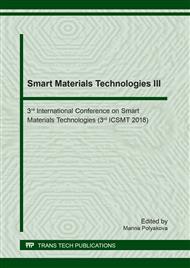[1]
E. Golubchik and M. Polyakova, in: Proceedings of the 2015 International Conference on Structural, Mechanical and Material Engineering, edited by M.F. Eldessouki and M. Kaloop. Vol. 19 (2015), p.17.
Google Scholar
[2]
B.S. Mitchell: An Introduction to Materials Engineering and Science for Chemical and Materials Engineers (John Wiley & Sons, Inc., New Jersey 2004).
Google Scholar
[3]
E. Golubchik, M. Polyakova and A. Gulin: Applied Mechanics and Materials Vol. 656 (2014), p.497.
Google Scholar
[4]
T.H. Wu, X.Y. Li and L. Li: Applied Mechanics and Materials Vol. 851 (2016), p.37.
Google Scholar
[5]
J. Zhang, Y.L. Zhu, G. Qi and J.Y. Li: Key Engineering Materials Vol. 727 (2017), p.670.
Google Scholar
[6]
Y.Q. Cui and S. Riffat: Applied Mechanics and Materials Vols. 71-78 (2011), p. (1958).
Google Scholar
[7]
A.L. Pisello, V.L. Castaldo, F. Rosso, C. Piselli, M. Ferrero and F. Cotana: Key Engineering Materials Vol. 678 (2016), p.14.
DOI: 10.4028/www.scientific.net/kem.678.14
Google Scholar
[8]
B.V. Ramnath, C. Parswajinan, C. Elanchezhian, S.V. Pragadeesh, P.R. Ramkishore, V. Sabarish: International Journal Applied Mechanics and Materials Vol. 591 (2014), p.120.
DOI: 10.4028/www.scientific.net/amm.591.120
Google Scholar
[9]
R.K. Dube: International Materials Reviews Vol. 35(1) (1990), p.253.
Google Scholar
[10]
C. Parswajinan, B.V. Ramnath, M. Vetrivel, P. Ramanarayanan, S. Bharath, T. Ajay and R.R. Chander: Applied Mechanics and Materials Vols. 813-814 (2015), p.9.
DOI: 10.4028/www.scientific.net/amm.813-814.9
Google Scholar
[11]
S. Guk, D. Milisova and K. Pranke: Key Engineering Materials Vol. 684 (2016), p.86.
Google Scholar
[12]
G. S. Upadhyaya: Materials Science Forum Vol. 835 (2016), p.1.
Google Scholar
[13]
S. Shima and M. Yamada: Powder Metallurgy Vol. 27(1) (1984), p.39.
Google Scholar
[14]
V.K. Sorokin, L.S. Shmelev and V.A. Vasil'ev: Development of process of rolling the metal powders (2003).
Google Scholar
[15]
K.A. Gogaev, G.Ya. Kalutskii and V.S. Voropaev: Powder Metall. Met. Ceram. Vol. 48(3) (2009), p.152.
DOI: 10.1007/s11106-009-9116-9
Google Scholar
[16]
K.A. Gogaev, G.Ya. Kalutskii and V.S. Voropaev: Powder Metall. Met. Ceram. Vol. 48(5) (2009), p.474.
Google Scholar
[17]
K.A. Gogaev, G.Ya. Kalutskii and V.S. Voropaev: Powder Metall. Met. Ceram. Vol. 48(7) (2009), p.384.
DOI: 10.1007/s11106-009-9153-4
Google Scholar
[18]
G.Sh. Huang, L.Y. Wang, Zh.W. Zhang, G.J. Huang and F.Sh. Pan: Materials Science Forum Vols. 488-489 (2005), p.445.
Google Scholar
[19]
V.P. Katashinskii and G.A. Vinogradov: Powder Metallurgy and Metal Ceramics Vol. 5(3) (1966), p.189.
Google Scholar
[20]
G.A. Vinogradov: Soviet Powder Metallurgy and Metal Ceramics Vol. 3(6) (1964), p.451.
Google Scholar
[21]
G.A. Vinogradov and V.P. Katashinskii: Powder Metallurgy and Metal Ceramics Vol. 4(9) (1965), p.722.
Google Scholar
[22]
V.P. Katashinskii: Powder Metallurgy and Metal Ceramics Vol. 20(11) (1981), p.754.
Google Scholar
[23]
O.A. Katrus and A.I. Otrok: Powder Metallurgy and Metal Ceramics Vol. 10(8) (1971), p.623.
Google Scholar
[24]
T. Hirohata, S. Masaki and S. Shima: Journal of Materials Processing Technology Vol. 111(1) (2001), p.113.
Google Scholar
[25]
Yu.F. Bahmatov, E.M. Golubchik, M.Ya. Mitlin and V.D. Golev, USSR Certificate of authorship 1,704,921. (1992).
Google Scholar
[26]
Yu.F. Bahmatov, E.M. Golubchik, M.Ya. Mitlin and V.D. Golev, USSR Certificate of authorship 1,743,694. (1992).
Google Scholar
[27]
Yu.F. Bahmatov and E.M. Golubchik, RU Patent 2,000,887 (1993).
Google Scholar
[28]
Yu.F. Bahmatov and E.M. Golubchik, RU Patent 2,192,320 (2002).
Google Scholar


